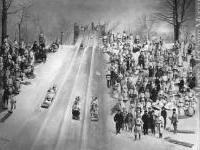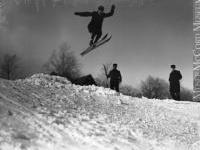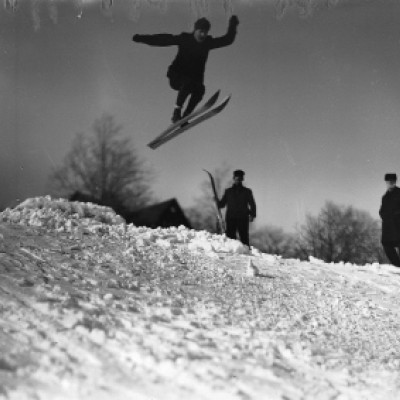 Mount Royal: as mountains go, it's not very big – only 233 meters (764 feet) in height on the main summit, and a diminutive 211 meters ( 692 feet) on the Outremont peak and an even less 201 meters (659 feet) for the Westmount peak lookout. It's an igneous intrusion that never was a volcano – merely a crystallized lump of magma resulting from a the passage over the Great Meteor Hotspot long ago in the Cretaceous. A truck sized sample of this black igneous core can be seen in the cellar level of the Smith House on Mount Royal Park.
Mount Royal: as mountains go, it's not very big – only 233 meters (764 feet) in height on the main summit, and a diminutive 211 meters ( 692 feet) on the Outremont peak and an even less 201 meters (659 feet) for the Westmount peak lookout. It's an igneous intrusion that never was a volcano – merely a crystallized lump of magma resulting from a the passage over the Great Meteor Hotspot long ago in the Cretaceous. A truck sized sample of this black igneous core can be seen in the cellar level of the Smith House on Mount Royal Park.
However, as the premier icon of our city, Mount Royal is an Everest among hills. The unusual geography of Montreal has determined much of our history, economically,politically and socially. Many cities are on islands, several have mountains, but we are unique in having both. As the surrounding country is so flat, Mount Royal looms larger than its actual size. Its great importance to the city also tends to make appear bulkier in our imagination.
Transportation up, down and through Mount Royal has always been an important aspect of our urban environment and the struggle between easy access and natural preservation has been ongoing for many years. In the time from initial settlement to about the 1830's, Montreal, or Ville Marie as the town proper was first known, the town limits barely stretched beyond what we now call Old Montreal, with a few farms that hardly passed beyond what is now Sherbrooke Street. The mountain was viewed as a source of timber for building and firewood. As the population was small, this didn't impact the forest all that much. There was an ancient Indigenous trail over the west side of the main peak that later became Cote des Neiges Road. By the end of the French regime, there was also a road to the north on the east side that became St.Laurent Boulevard and one towards the west that eventually became Cote St. Antoine Road. The mountain was still rural and pretty much pristine.
 As Montreal grew in the nineteenth century, it expanded up towards Mount Royal. To preserve part of the mountain as a public park, the well known landscape architect, Frederick Law Olmsted was engaged to create a plan. This was the basis of what we see today with Beaver Lake, the various lanes, footpaths and steps. Olmsted believed that people should access the mountain slowly and on foot. Although not a long climb of course, there are steep sections before the summit and some quite rocky terrain as well. The appeal of a quicker access to the top was no surprise.
As Montreal grew in the nineteenth century, it expanded up towards Mount Royal. To preserve part of the mountain as a public park, the well known landscape architect, Frederick Law Olmsted was engaged to create a plan. This was the basis of what we see today with Beaver Lake, the various lanes, footpaths and steps. Olmsted believed that people should access the mountain slowly and on foot. Although not a long climb of course, there are steep sections before the summit and some quite rocky terrain as well. The appeal of a quicker access to the top was no surprise.
In 1885, a funicular railway was built, and served to carry people to the pinnacle until 1918. It was then found to be structurally unsafe and was dismantled by 1920. However,in its day it was a popular, if quite frightening looking, ride, that charged five cents for adults, three for children, and carried those who wished to avoid the hot, uncomfortable climb. Funiculars operate by an ascending-descending counterweight system. The Mount Royal funicular was also powered by steam. It had a fairly gentle start and then a steep ascent. It was located near the corner of Park Avenue and Duluth Street and passed near to the stairs behind the present Royal Victoria Hospital and the McGill student residences.
 By the turn of the twentieth century, Mount Royal had become easily accessible by streetcar. The Number 11 approached Mount Royal up Cote des Neiges Road and turned along the present Camillien Houde Parkway. After our streetcars were retired in the 1950's, the Number 11 bus followed this route.
By the turn of the twentieth century, Mount Royal had become easily accessible by streetcar. The Number 11 approached Mount Royal up Cote des Neiges Road and turned along the present Camillien Houde Parkway. After our streetcars were retired in the 1950's, the Number 11 bus followed this route.
There is also a tunnel through the mountain, built 1914 to 18, that now belongs to the Canadian National Railway and is presently a commuter line. It is doubtful if a tunnel could be approved now.
Other structures on the mountain tended to be purely recreational. There has been a ski tow, and even a ski jump. There were toboggan slides. These all disappeared by the 1950's, as winter sports moved outside of metropolitan Montreal to the Laurentians and other off-island sites. There are still good cross country skiing trails and skating at Beaver Lake.
The best way to really feel that Mount Royal is a true mountain, worthy of the name, is , of course to climb up the various staircases, many offering interesting house and garden viewings on the way. Taking the time to see the city arrayed below as we climb is among the greatest Montreal experiences.
